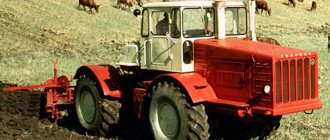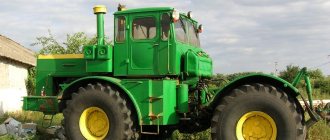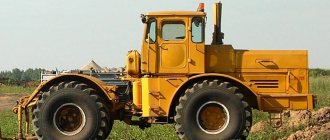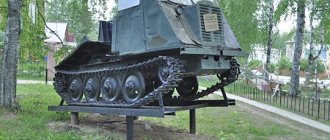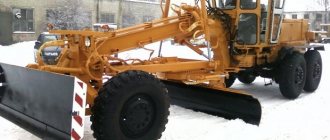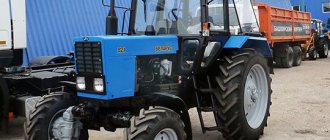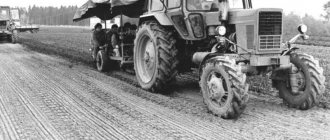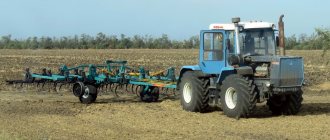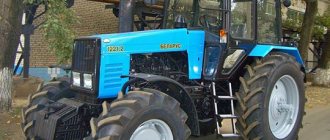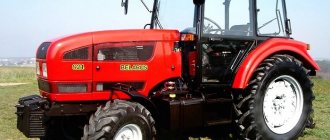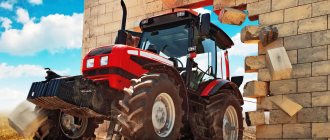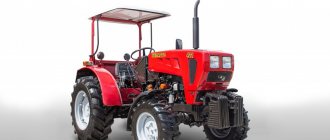Category: TRACTORS
- The appearance of the T-40 tractor
- Technical characteristics of the T-40 tractor
- T-40 tractor engine
- Gearbox of the T-40 tractor
- Tractor transmission and chassis
- Hydraulics
- Tractor modifications
Each time has its own legends, and if we consider the sixties of the last century, the T 40 tractor is one of them. Even in our time, when sixty years have passed since the release of the first “forty”, when talking about tractors, the image of the T-40 pops up in the average person.
The T40 began in 1961, when the first tractor left the workshops of the plant in Lipetsk. The model became iconic for the organization, as in subsequent years it was used as the basis for a series of specialized equipment.
Tractor T-40AM:
Due to its reliability and technical characteristics, the T 40 tractor has become a bestseller among workers and farmers. The car has been noticed internationally, as evidenced by numerous awards. The popularity is confirmed by the number of machines created, during production (1961-1995) 1.2 million copies, which, despite time, still work for the user.
Technical characteristics of T-40, weight
| Main characteristics | |
| Weight | 2,595 kg |
| Movement speed | 2.23-26.68 km/h |
| Ground clearance | 500 mm |
| Track width | 1 200-1 800 mm |
The T-40 tractor is a universal model that can be used with a wide range of attachments: a snow blade, a snow blower, a mower, a front loader bucket, etc. Also, this tractor was and is still used to this day during plowing and harvesting, during demolition of buildings and in the public sector.
Tractor technical characteristics
The T 40 tractors have been and are still in high demand due to their excellent characteristics. Among them stands out:
- Reliable engines D-37 and D-144, 38 and 50 hp. With. respectively;
- Weight without attachments – 2.3 tons, with attachments – 2.6 tons;
- Travel speed ranges from 1.5 to 28 km/h;
- Number of speeds – 7 forward and 7 reverse;
- Traction force – 0.9 tf;
- Ground clearance – 50 cm;
- The track can be adjusted from 120 to 180 cm.
The dimensions of the tractor are quite modest. The length of the unit is 3.66 and the width is 1.62 m. The height of the tractor is 2.1 m.
The machine manufacturer did not stop at achieving the listed characteristics, so the design of the units was improved from time to time. This is how the T 40 A tractor appeared, which featured a more powerful engine and an improved decompressor. The following representatives - the T 40AM tractor, in addition to the listed improvements, were equipped with a modernized suspension, generator and gearbox. This made it possible to use the unit in tandem with a coon, which could not be achieved when the previous model, the T40A tractor, was used.
It should be noted that there is no need for special maintenance of the machine. The engine, transmission, clutch and other main components are easy to repair. If necessary, the machine can be improved by modernizing the blade or replacing elements for attaching the winch. All that is required when repairing and modifying the unit with your own hands is to carefully study the drawings from the tractor’s registration certificate and purchase or independently grind a suitable part.
The tractor's refueling capacity also deserves special attention. Both when working in the field and when driving on an asphalt road, thanks to the improved fuel system, the machine does not have a fairly modest fuel consumption. This makes the tractor one of the most economical units in its class. Below we will study in detail each of the tractor components and consider the areas of application of the unit.
Engine
The T-40 tractor was equipped with two different models of 4-cylinder power units: D-37 or D-144 (manufacturer: Vladimir Tractor Plant). The engine was started in most cases using an electric starter. The PDV starting gasoline engine was used less frequently.
| Engine model | Characteristics |
| D-37 | |
| Power | 37 hp (27 kW) |
| Rotation frequency | 1,500 rpm |
| Torque | 192 |
| Fuel consumption at operating power | 246 g/kW |
| D-144 | |
| Power | 50 hp (37 kW) |
| Rotation frequency | 1,800 rpm |
| Torque | 205 |
| Fuel consumption at operating power | 248 g/kW |
It is noteworthy that the shape of the body depended on the type of engine installed. For example, if the car was equipped with a D-37, then the hood was rounded. If D-144, then the hood is rectangular.
Photo source: spectechzonecom.com There are 7 modifications of the T-40 model
Fuel consumption is an important technical indicator
The fuel consumption values for different models of the T-40 tractor differ, since different types of engines and the specifics of the work performed change consumption in accordance with the size of the loads. The consumption of the basic tractor model, declared back in Soviet times, was 7.2 kg/h. This is an average value and does not reflect actual loads or specific operating conditions. There is a formula for calculating the amount of fuel consumed:
P = 0.7 × R × N.
Where:
- P —calculated flow rate;
- R — fuel consumption according to the passport;
- N —motor power;
- 0,7 — power conversion factor per hp. With. in kW.
Using this formula, you can calculate the approximate fuel consumption, which will help you stock up on the required amount in advance.
Starting motor circuit
T-40 modifications
A total of seven different modifications of the T-40 tractor were produced: three with the D-37 power unit, four with the D-144.
| Model name | Main characteristics |
| Modifications with D-37 engine | |
| T-40A | All-wheel drive model |
| T-40AN | Low ground clearance model for working on slopes |
| T-50A | Industrial model with loader |
| Modifications with D-144 engine | |
| T-40M | Rear wheel drive model |
| T-40AM | All-wheel drive model |
| T-40AMN | Low ground clearance model |
| T-40AP | All-wheel drive model for municipal services |
Purpose
The Sorokovka tractor is designed for agricultural and road work. When performing agricultural work, it can be used for:
- plowing fields with light soil;
- performing excavation and cleaning work in greenhouses;
- loading of necessary materials;
- transportation of goods, materials and harvested crops;
- harvesting garden crops;
- processing of grain, silage and soybean crops, grasses, cereals, soybean plantings,
- sunflower;
- mowing vegetation;
- hundred-throwing.
The tractor is used to perform utility work, remove snow and dirt. Can be used for simple earthworks to equip embankments and level areas.
Tractor T 40
Gearbox, clutch
The T-40 is equipped with a supporting manual transmission with transverse shafts, to the crankcase of which the power unit is connected. The gearbox has a reverse mechanism, which is available for all seven gears. Another feature of the model is the installation location of the bevel gear, which is located behind the clutch.
If it is necessary to perform work at low speed, it is possible to install a creeper (mechanical or hydraulic).
A smooth start and a softer gear shift mode are ensured by the clutch of the T-40 model.
Photo source: usedauto.com.ua Photo T-40
Device
T 40 consists of a set of main components and assemblies. These include:
- chassis;
- transmission;
- hydraulics;
- Transmission;
- steering;
- power point;
- cabin;
- attachments.
The tractor and additional equipment are controlled by the tractor driver from the cab.
Cabin T 40
Cabin
The single-seat cabin is a frame frame that protects the tractor driver in the event of a tractor rollover. There is a door on the left side. The remaining sides are made of glass panels, which are fixed in the frame. Thanks to full glazing, the tractor driver has an all-round view, which allows him to control the quality of work. There is a windshield wiper on the windshield. There is no air conditioning or heating system for the cabin. There is a fan in the cab to the right of the tractor driver. For heating, the exhaust gas exhaust duct, which is passed through the cabin, is re-equipped. Controls and controls are located in the front of the cabin. The dashboard contains sensors for oil pressure and temperature, fuel reserve, battery charge level and air pressure. The steering wheel and pedals have a classic installation option. The gearbox, reverse and auxiliary equipment levers are installed to the right of the steering wheel. The overall configuration of the cabin and the location of the control levers create ease of operation.
Optional equipment
Due to its high versatility, maneuverability and power, several attachment options have been developed for the T 40 tractor. This can be trailed agricultural equipment:
- plows and cultivators for cultivating land;
- grain fillers for sowing;
- harvesting equipment;
- stacker.
The tractor can perform the functions of a front loader. With a trailed bunker it can be used as a carrier for crops, silage, and mixed feed. To perform excavation work, the tractor can be equipped with an excavator bucket or a bulldozer blade. A saw or crusher can be installed to remove asphalt.
Maintenance
Despite the fact that the T-40 tractor has not been produced for more than 20 years, the model still has fans who prefer to use this particular machine for a number of advantages.
This:
- compatibility with “attachments” originally manufactured for other brands of equipment;
- high rates of maneuverability and maneuverability on different types of soil;
- reliability, durability, ease of operation and maintenance;
- availability of spare parts.
However, the T-40 tractor also has a number of disadvantages:
- engine (air cooling of the power unit (poor heating in the cold season and insufficient cooling in the heat);
- cabin (no possibility of heating inside in winter and no cooling system in summer).
Photo source: youtube.comThe T-40 tractor has a load-bearing manual transmission
Advantages and disadvantages of the T-40 tractor
Pros:
- High cross-country ability on any soil.
- Ease of maneuvering at any speed.
- All tractor functionality is available in reverse.
- Ease of control.
- Versatility: the ability to be equipped with attachments for other types of machines (T-25, “Belarus”).
- No problems with spare parts and maintenance.
- Reliability, durability.
- The steering of the tractor is equipped with power steering.
T-40 tractor with attachments
Cons
The main disadvantage of the tractor is the air cooling of the engine. Because of this, operational difficulties arise:
- Cooling is not effective enough in hot weather.
- It is difficult to warm up the engine before starting it in winter.
- Lack of heating and air conditioning in the driver's cabin, which makes work in hot and cold conditions uncomfortable.
Transmission faults
When operating the T-40 tractor, a number of problems associated with switching gears may arise. To prevent them, you must adhere to a maintenance schedule and change lubricants regularly. The oil is used exclusively for the season. The recommended frequency of checking the gearbox is 240 operating hours. Transmission parts and assemblies are washed every 960 hours of operation to eliminate solid particles.
Gearboxes of agricultural machines with the T-40 index are quite repairable. Their maintenance is as follows:
- the completely shut down machine is installed in a place equipped with anti-roll bars for repairs;
- drain the transmission fluid;
- disconnect all nodes, which allows you to get completely close to the device;
- remove the driveshaft, and then the gearbox itself;
- remove dirt from the box and disassemble the unit;
- open the fifth speed cover and inspect the fork and then replace it if necessary;
- remove all shafts and couplings, inspect the gears for wear;
- install new bearings;
- Reassemble the gearbox in reverse order.
Repair work must be carried out when the locking elements fail, which is considered to be the cause of the gear shift failure. In this case, the tractor is completely turned off, and the shift lever is moved to the neutral position. The following sequence of actions is performed:
- include the main coupling;
- remove the plug from the locking device;
- move the shift lever to the extreme position;
- remove the fork from the traction;
- adjust the blocking device;
- reinstall the fork pin.
